#Frederiksborg Palace Museum
Text

Oil Painting, 1787, Danish.
By Jens Juel.
Portraying Princess Louise Augusta of Denmark in a white chemise dress.
Frederiksborg Palace Museum.
#Louise Augusta of Denmark#womenswear#dress#1787#1780s#1780s dress#1780s painting#1780s Denmark#Danish#Jens juel#Frederiksborg Palace Museum#chemise à la reine
27 notes
·
View notes
Text


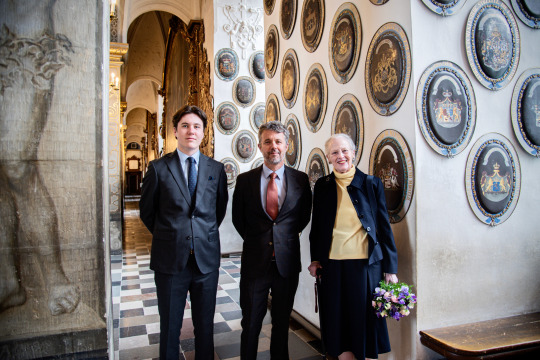
Hanging of The Crown Prince’s Order of the Elephant escutcheon
In connection with a private tour of The Museum of National History at Frederiksborg Palace in Hillerød for HM The King, HRH The Crown Prince and HM Queen Margrethe, The Crown Prince’s Order of the Elephant escutcheon was hung in the Chapel of the Royal Danish Orders of Knighthood in the Palace Church.
More at
https://www.kongehuset.dk/en/news/hanging-of-the-crown-princes-order-of-the-elephant-escutcheon
#Crown Prince Christian of Denmark#King Frederik X of Denmark#Queen Margrethe II of Denmark#danish royal family
2 notes
·
View notes
Text

”Entombment of Christ” - ”Kristi Gravlæggelse” - painted between 1865 and 1879 by Carl Heinrich Bloch (1834 - 1890). Oil on copper plate; dimensions: 104.1 x 83.8 cm or 41 x 33 in. Current locetion: Museum of National History at Frederiksborg Palace in Hillerød north of Copenhagen, Denmark.
The body of Christ, wrapped in a clean linen sheet, rests on a wooden bier at the entrance of the tomb. Joseph of Arimathaea stands at the rectangular opening hewn from the rock and directs the placement of the body. Since it was the burial custom of the Jews, Nicodemus makes the final preparations by placing the spices in the linen cloth that enfolds the body of the Lord. The mourners stand near the feet of Jesus. John, holding the crown of thorns, is with both the Virgin Mary and Mary Magdalene. White flowers alongside the bier indicate the hope of the Resurrection.
Carl Heinrich Bloch was born in Copenhagen. In January 1849, he began study at the Royal Danish Academy of Art and in 1855 he became a member of it. In 1859, he received a travel grant, which he used to study in Holland, France, and Italy. Carl Bloch met his wife, Alma Trepka, in Rome, where he married her in May 1868. They had a very happy and prosperous life together until her early death in January 1886. The sorrow over losing his wife weighed heavily on Bloch, and being left alone with their eight children after her death was very difficult for him. He died of cancer on February 22, 1890.
2 notes
·
View notes
Text
Frederiksborg Castle
It is a palace complex in Hillerod, Denmark.
It was a royal residence for Christian IV of Denmark and Norway, during the 17th century.
From 1882 until today it is the National History Museum of Denmark, with portraits, paintings and furniture. It still hosts special exhibitions.
In 1659 the castle was occupied by the Swedes who took most of the works as war reparations.
Its main rooms are the…

View On WordPress
0 notes
Photo





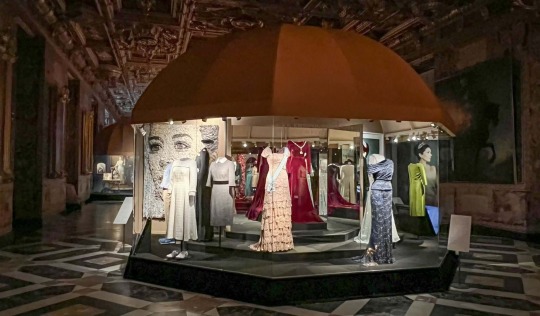
Crown Prince Frederik and Crown Princess Mary, along with their three children Princess Isabella, Prince Vincent and Princess Josephine, attended the opening of the special exhibition "HRH Crown Princess Mary 1972-2022" at the National History Museum at Frederiksborg Palace.
#crown prince frederik#crown princess mary#princess isabella#prince vincent#princess josephine#danish royal family#mary 50 bday#mine#100 notes
199 notes
·
View notes
Text
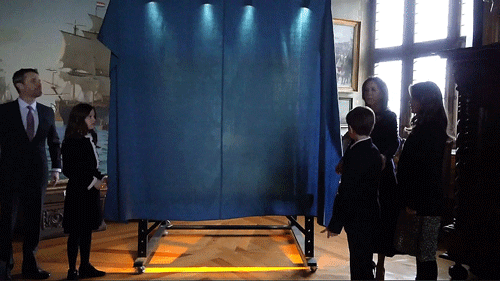

3 February 2022—The National History Museum, Frederiksborg Palace, Hillerød, Denmark—Accompanied by her husband and three youngest children, Crown Princess Mary unveils a new portrait created for the occasion of her 50th birthday. The painting by Spanish-born, Danish-based artist Jesús Herrera Martínez will be on display as part of the exhibition H.K.H Kronprinsesse Mary 1972-2022, which runs from 4 February to 31 August 2022.
#Crown Princess Mary#Princess Josephine#Crown Prince Frederik#Princess Isabella#Prince Vincent#Danish Royal Family#Kronprinsesse Mary#Prinsesse Josephine#Kronprins Frederik#Prinsesse Isabella#Prins Vincent#House Glucksburg Monpezat#[\/]#[\/] drf#Mary's 50th#official portraits#i got a little nauseated making this#sorry if they make you feel a little ill as well#so much little camera movement#photosensitivity#i tried to edited out as much of the flashes as possible#anyway#lol at Phine
43 notes
·
View notes
Photo



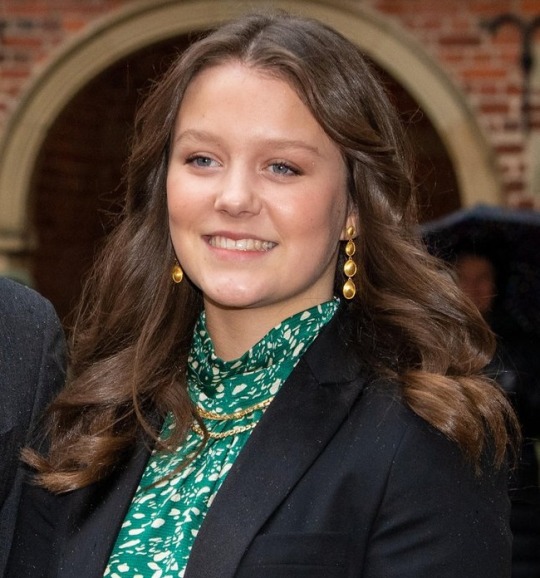


Crown Princess Mary, Princess Isabella and Princess Josephine of Denmark at the opening of the exhibition "H.K.H. Crown Princess Mary 1972 - 2022" in The National History Museum at Frederiksborg Palace - 03.02.22
12 notes
·
View notes
Note
Hey Zelia! I'm planning on visiting Copenhagen in the summer and I was wondering, what would you recommend seeing as a royal watcher and as a regular tourist?
Hi anon! Sorry for replying so late 🙃 That sounds very exciting! Maybe this tag would be interesting to you.
I'd definitely recommend a day trip to Hillerød to visit Frederiksborg Palace. I've raved on about it before but it's just my favourite of all our palaces. It's the most accessible (in terms of how much of the palace you're allowed access to); it always has bomb ass exhibitions but even without the exhibitions, there's so much to see and take in; and the palace gardens are stunning and definitely worth a visit. AND the Mary50 exhibition at Frederiksborg runs to 31 August!
Speaking of current exhibitions, of course there's also the Amalienborg Museum's much talked about jewellery exhibition. I haven't seen it personally – I got the book on which it was based for my birthday and I'm satisfied with that considering how relatively expensive the museum is to visit 🙈 But if you're a jewellery buff, I suppose that's definitely worth a visit.
As for non-royal things, I can't remember when I've mentioned in past posts but off the top of my head: the National Gallery (Statens Museum for Kunst), Davids Samling (the David Collection), Thorvaldsens Museum (the Thorvaldsen Museum), Reffen (street food market), Cisternerne and Blågårdsgade (>>>>>> Strøget) ✌️ If you want more information or recommendations, feel free to ask again 😊
#yes im a cheapskate and what about it#frederiksborg >>>>>> any other palace in denmark#iirc in the coming tag i've answered an ask about all the palaces in and around copenhagen#denmark tag#inquiring minds#anonymous
5 notes
·
View notes
Photo


Christen Købke (May 26, 1810 - 1848) was a Danish National-Romantic painter from the Golden Age of Danish art. He was trained at Eckersberg’s School of Painting, traveled abroad to Italy, but upon return failed to be accepted by the Royal Academy. This is said to have broken his spirit and he died young from pneumonia.
Now he is considered the most talented Danish National Romantic artist, and he did master both portrait painting, landscapes, interiors and genre painting in almost equal measure. I like his landscapes, esp. those showing Copenhagen, the Danish capital as a semi-rural city.
Above: Dosseringen set fra Havet, 1837 (oil on paper, glued onto canvas), The Danish National Museum
Frederiksborg Palace seen from Jægerbakken. Evening. 1835 (oil on canvas) Den Hirschcprungske Samling
#art#danish artist#christen købke#1830s#national romanticism#golden age of danish painting#golden age painters#landscape painting#dosseringen#frederiksborg castle#eckersberg's malerskole#danish royal academy#copenhagen#danish national museum#den hirschsprungske samling
15 notes
·
View notes
Text

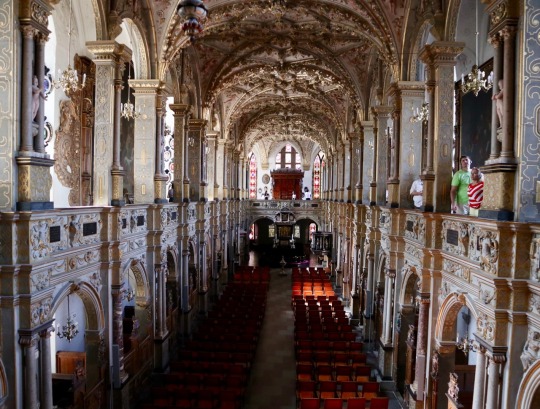








Two words - castle overload!
I started off the day taking a train out of the city to check out Frederiksborg Castle, which is a Renaissance castle from the 17th century and has become a museum of natural history since 1878. The castle gives you a great sense of Danish history (many rooms in chronological historical order too!) in addition to the changing styles over the years. I loved seeing all the different coats of arms hanging on the walls since I’m currently reading Game of Thrones and this is currently all very relevant and real to me, lol.
I then went back to Copenhagen and visited Christiansborg Palace, which is still very much a working Palace as it houses the Parliament and the Supreme Court, in addition to various royal functions. I really liked the decor in the reception rooms and especially loved the library 😍.
The picture that says ‘You are now entering the EU’ is taken from Freetown Christiana, an ‘anarchist commune’/‘self proclaimed independent state’ where pictures aren’t allowed (kind of ironic) - probably partly because weed is illegal and people are smoking and selling it EVERYWHERE. There’s a street where literally every few feet someone has a small stand set up (think lemonade stand but without the lemonade) ready to sell a concoction of soft drugs of different forms and flavours. I didn’t feel unsafe but it was also quite a strange experience for a girl who has never even been drunk in her life hahaha.
Taking full advantage of the city pass, I hopped onto a canal tour after dinner and enjoyed it more than I thought I would. We passed under bridges so low we had to duck our heads, drifted past the little mermaid, saw many main sights from the water, and even passed people swimming in the canals (which I can’t imagine anyone doing in The Hague) because the water is so clean!
Last, I met up with a new friend and his local friend to check out Tivoli together. It’s not quite what I expected - less amusement park and more restaurants but still super cool and beautiful. There was even a free outdoor concert at 10pm which was awesome :)
6 notes
·
View notes
Text

The Nordic Museum, the design of Isak Gustaf Clason, was completed in 1907 after a 19-year construction process. Originally, it was intended to be a national monument housing the material inheritance of the nation. It was, however, only half-completed for the Stockholm Exposition 1897, and it never was completed to the extent originally planned, three times the actual size. It takes its style from Dutch-influenced Danish Renaissance architecture (i.e. buildings such as Frederiksborg Palace) rather than any specifically Swedish historical models. (Nov 2018)
#stockholm#sweden#photographers on tumblr#photography#my photos#sverige#urbanphotography#urbanphotoshoot#original photographers#original post#architecturephotography#architecture#djurgården#scandinavia#nordics#nordic museum#nordiska museet
33 notes
·
View notes
Text
Prince Christian of Denmark, Princess Isabella of Denmark and Princess Josephine of Denmark attend the unveiling of a new portrait of Crown Prince Frederik of Denmark on the occasion of his 50th birthday (on May 26th 2018) at The Museum of National History at Frederiksborg Palace in Copenhagen, Denmark -May 24th 2018.

#prince christian#princess isabella#princess josephine#danish royal family#denmark#2018#crown prince frederik#crown prince frederik's 50th birthday#50th birthday#birthday
6 notes
·
View notes
Photo


Through the Years → Mary, Crown Princess of Denmark (516/∞)
24 May 2018 | In this handout image provided by MEW and The National History Museum, Crown Prince Frederik of Denmark, Crown Princess Mary of Denmark with children Prince Christian, Princess Isabella and the royal twins Princess Josephine and Prince Vincent during the unveiling of a portrait of Crown Prince Frederik by Australian painter Ralph Heimans at Frederiksborg Palace in Hillerod, Denmark. The exhibitions 'Ralph Heinmans Portraits' and 'HRH Crown Price Frederik - Prince of Denamrk' both open on the occasion of the 50th birthday of The Crown Prince Frederik of Denmark. (Photo by Handout / MEW / The National History Museum)
7 notes
·
View notes
Text
Northern Europe Trip - 9 Days
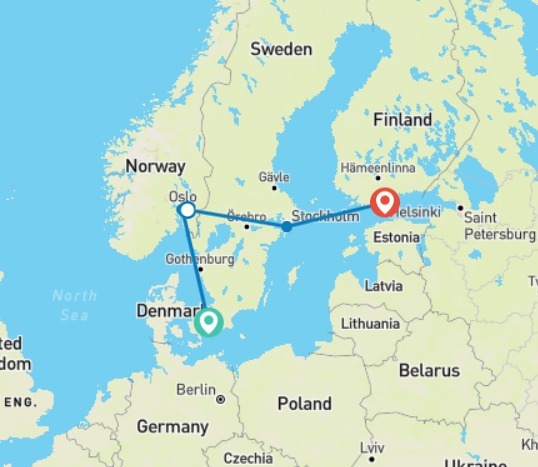
** The trip was revised on 06/19/2021 **
Northern Europe Trip - 9 days
August 14 (Sun) ~ August 22 (Mon)
Start in Copenhagen and end in Helsinki! With the Discovery tour Capitals of Scandinavia. The tour includes accommodation, an expert guide, meals, transport and more.
*** Destinations:
Copenhagen (Denmark)
Oslo (Norway)
Stockholm (Sweden)
Helsinki (Finland)
Live a little lagom and travel to northern Europe's historic, stylish and cosmopolitan cities on this fairy-tale Scandinavia tour. You'll learn about the area's Viking history, why Helsinki is the capital of cool and dine amidst the former hunting and fishing grounds of Swedish kings.
Day 1: Welcome to Copenhagen
Day 2: Explore Historic Copenhagen
Day 3: Journey to Oslo
Day 4: Vikings and More in Oslo
Day 5: Onwards to Stockholm
Day 6: Discover Beautiful Stockholm
Day 7: Embark on an Overnight Cruise
Day 8: Arrive in Vibrant Helsinki
Day 9: Farewell Scandinavia
*** Trip cost: $2,725 per person ***
The above trip cost is based on a twin shared hotel room. If you are a solo traveler, you will be matched with a fellow traveler of the same gender. If you like to enjoy the comfort and privacy of your own room through the trip, the single supplement is $640.
*** Payments: $400 non-refundable deposit at booking. Balance payable by June 30, 2022.
*** Reservation:
Send an email to [email protected], booking and payment instructions will be emailed to you. Email or call Felix at 904-628-1688 for any questions.
*** What’s Included:
*Twin shared hotel room. If you are a solo traveler, you will be matched with a fellow traveler of the same gender.
*Guide: An expert Travel Director and professional Driver.
*Transport: Air-conditioned coach. Any public transport used as part of the tour (excludes free days).
*Meal: 8 breakfasts and 3 dinners are included.
*Additional Services:
Explore Copenhagen, Oslo, Stockholm and Helsinki with a Local Specialist
Visit Vigeland Sculpture Park in Oslo and the City Hall in Stockholm
View the Little Mermaid in Copenhagen and Finlandia Hall in Helsinki
See Børsen, Christiansborg Palace and Amalienborg Palace in Copenhagen, Akershus, the Royal Palace and the Opera House in Oslo, Storkyrkan, Riddarholmen Church and the Royal Palace in Stockholm, the Sibelius Monument, the Olympic Stadium and the Opera House in Helsinki
Overnight Cruise from Sweden to Finland
Scenic Cruise across the Baltic Sea
Connect with Locals Indulge in an eco-friendly organic dining experience featuring home-grown produce sourced from within Stockholm's Djurgarden Park, the former hunting and fishing grounds of Swedish kings. (Day 6)
Dive into Culture Visit the Stockholm City Hall, with its spire featuring the golden Three Crowns. You'll have an opportunity to visit one of the city's most famous landmarks. (Day 6)
Stays with Stories Step into decades of Danish history and in the footsteps of aristocrats and royals when you stay at the 17th-century Phoenix Hotel in Copenhagen. (Day 1)
Audio Headsets for flexible sightseeing
Daily breakfast and up to half your evening meals
Ferry from Helsingør to Helsingborg
Cherry-picked hotels, all tried and trusted
Optional Experiences and free time
All porterage and restaurant gratuities
Must-see sightseeing and surprise extras
An expert Travel Director and professional Driver
All hotel tips, charges and local taxes
*** Itinerary:
Day 1: Welcome to Copenhagen
Hans Christian Andersen would have been right at home in 21st-century Copenhagen. The Danish capital hasn't lost any of its fairy-tale flair over the centuries, as you'll come to discover when you spend your first day exploring this colourful city. On arrival, transfer to your Stays With Stories accommodation, the historic Phoenix Hotel in the heart of Copenhagen's most elegant district. Discover the hotel's rich history from the late 17th century, through the World Wars and today, restored to its former glory. Then, spend your free time soaking up the sunshine with the fun-loving locals before joining your Travel Director and fellow travellers for a Welcome Reception.
Day 2: Explore Historic Copenhagen
Connect with the heartfelt hygge of your Danish hosts when you join a Local Specialist this morning for a sightseeing tour that will reveal all the highlights of Copenhagen's Old Town. See the distinctive dragon-tail spire of the 17th-century Børsen (Stock Exchange), Christiansborg Palace and the Little Mermaid, demurely seated on a rock overlooking Langelinie Promenade. See the home of Denmark's beloved royal family, Amalienborg Palace, then spend the rest of the day exploring Copenhagen your way. Enjoy a cold øl overlooking the colourful façades of Nyhavn or perhaps join an Optional Experience to the Danish Riviera, past ancient fishing villages to the 17th-century Frederiksborg Castle.
Day 3: Journey to Oslo
For now, it's a fond farvel to Copenhagen and a bright and cheery hej to Sweden, as you cross the Øresund by ferry and wind your way north, through the Swedish countryside past Gothenburg to Norway. You'll want to keep your camera at the ready to capture the scenic landscapes that line your route to Oslo, Norway's down-to-earth capital, where the Norwegian philosophy of friluftsliv can be felt along the flower-lined boulevards and bustling waterfront promenades.
Day 4: Vikings and More in Oslo
Tread in the footsteps of the Vikings this morning as you join your Local Specialist for a sightseeing tour that will reveal Oslo's long-standing seafaring heritage. See the medieval fortress of Akershus, the elegant Royal Palace and Oslo Opera House, which seems to rise up from the water in all its marble, granite and glass glory. Visit a wonderland of Norwegian sculptures left behind by Gustav Vigeland in his sculpture park, then enjoy a free afternoon to explore the city on your terms. You could choose instead to embark on an Optional Experience to see the three original Viking long-ships at the Viking Ship Museum and delve into Roald Amundsen's spontaneous race to the South Pole at the Fram Museum.
Day 5: Onwards to Stockholm
Enjoy a scenic drive south through Norway's lush forest landscapes to Sweden, bound for its enchanting capital. You'll journey through Karlstad situated on Lake Vänern, the largest lake in Sweden, and pass Örebro, with its 13th-century castle, before continuing to Stockholm. Indulge in a free evening to explore 'Beauty on Water', as the locals refer to their capital. Consider joining an Optional Experience to the cobbled Gamla Stan to admire its medieval history on a walking tour, followed by a traditional Swedish meal in a local restaurant.
Day 6: Discover Beautiful Stockholm
Style and substance are things Stockholm has in abundance, as you'll discover when you join your Local Specialist for a sightseeing tour this morning. See Stockholm's historic mother church, Storkyrkan, and the Royal Palace, then Dive Into Culture and visit the City Hall. You'll have some free time this afternoon to join the locals for their afternoon fika (coffee break) and embrace the Swedish philosophy of lagom before joining your fellow travellers at an exclusive eco-friendly Be My Guest experience and Connect With Locals over dinner amidst the former hunting and fishing grounds of Swedish kings.
Day 7: Embark on an Overnight Cruise
A leisurely start to your day could see you embark on some last-minute souvenir shopping or savouring steaming sweet Swedish cinnamon rolls in Stortoget. Consider an Optional Experience to the Vasa Museum. The cool capital of Finland beckons as you board your overnight cruise to Helsinki, passing through Stockholm's archipelago as you watch the sun set over the Baltic Sea.
Day 8: Arrive in Vibrant Helsinki
Continue your cruise across the Baltic, arriving in Helsinki in time to join your Local Specialist for a sightseeing tour of all the city's highlights, its Swedish and Russian heritage and some hidden gems. See the modern marble façades of Finlandia Hall, the Senate and the colourful stalls in Market Square before joining your fellow travellers for a Farewell Dinner. Raise a glass of aquavit and toast to your epic adventure across the capitals of Scandinavia. Kippis!
Day 9: Farewell Scandinavia
After a memorable journey exploring the history and culture of four Scandinavian nations, all that's left is to say a fond farewell to your new friends and prepare for your return journey home. Find out more about your free airport transfer at trafalgar.com/freetransfers.
*Airfare from and to the US, Insurance, Visa fees, optional excursions, optional activities, and services are not included in the trip cost.
This trip is organized by Travel Around the World Together Group, owned and operated by Global Travelers Society, Inc. a non-profit organization, all rights reserved.
0 notes
Text
where: euphemiasburg

Die königliche Domäne von Euphemiasburg (The Royal Domain of Euphemiasburg, or simply, Euphemisburg) is the previous official residence of the monarch of Mecklenburg. Built in the woods east of Bad Doberan, and west of Rostock, construction began in April 1922 after three years of planning and was completed in August 1936. It was one of the largest public works projects of the time and employed over 10,000 men and women (with over half of the workers being First World War veterans). Euphemiasburg is named after Euphemia of Sweden, an ancestress of the House of Mecklenburg, who died in 1370.
King Heinrich Ludwig I, and his wife Queen Karola, and their two children, Crown Prince Paul Friedrich and Princess Marie Elisabeth, moved into the palace in March 1932 after the majority of construction was completed. Following the Nazi invasion of 2 June 1937, Paul Friedrich and Marie Elisabeth fled to Denmark while their parents remained in Mecklenburg. The King and Queen were moved to Schweriner Schloss a couple of years later where they remained for the rest of the war.
Due to the Soviet occupation of the western regions of Mecklenburg, including the former capital city of nearby Rostock, Euphemisburg wouldn't become a royal residence again until the 1970s when the children and grandchildren of King Paul Friedrich II and Queen Thyra required residences of their own. Euphemiasburg's size was easily able to house them.
Following the reunification of Mecklenburg in 1990, the royals soon vacated the palace, moving into smaller homes previously inaccessible due to the Soviet occupation. In 1991, King Wilhelm Franz I decreed that Euphemiasburg would become the traditional residence of the Crown Princes and Princesses of the realm, the first being his daughter, Karolina Augusta.
Karolina Augusta would never occupy the palace. Her father died on 20 January 1992 and she ascended the throne as Karolina Augusta I of Mecklenburg, aged three.
Queen Eleonora opened the palace and grounds to the public in 1993. The royal domain is open to the public almost year round, only closed when in use by the royal family.
Euphemiasburg remains in royal use, both officially and unofficially. The Thanksgiving Service and the New Year's Honours Banquet are hosted at the palace each year on the Sunday after Whitsunday. The Kingdom Day Honours Banquet is hosted at the palace each year on the first Sunday of October. The House of Mecklenburg hosts members of the Royal Families of Denmark, Norway and Sweden each July for Scandiburg Weekend at the palace. The family often holds large family gatherings at Euphemiasburg due to the palace's large number of suites. These include weddings, birthday parties, and anniversaries. All members of the Royal House and Family of Mecklenburg are baptised at the nearby Doberan Minster and post-baptism celebrations are held at Euphemiasburg. State visits do not usually include events at Euphemiasburg.
The main palace is situated in the middle of a man made island, surrounded by canals. There are two mews wings flanking the south facade of the palace. The land slopes down after the palace, with cascades and a tiered English style garden, culminating in a large man-made lake. There are two smaller canals bordering a formal French garden and flanked by an orangery and a greenhouse. Further administration buildings were planned but never built. There are sub-basements tunnels connecting the mews buildings to each other and the main palace.
Euphemiasburg is the largest royal palace in the world by floorspace (approx. 269,375 square metres for the main palace structure - not including the sub-basement tunnels), and by volume (approx. 2,208,875 cubic metres for the main palace structure - not including the sub-basement tunnels ). For comparison’s sake, Buckingham Palace has a floorspace of 77,000 square metres. The north and south facade of the palace is 270 metres across and the east and west facades are 340 metres across.
While criticised for its vast size, Euphemiasburg was originally intended to be a multigeneration palace. When planning began in 1919 it was assumed that Schweriner Schloss and Schloss Ludwigslust would remain in the possession of the former Grand Duke’s family in perpetuity.
Keep reading for more information and to view “images” of this fictional estate (no spoilers).

Exterior
The building's exterior is modelled on Frederiksborg Castle and Rosenborg Castle of Denmark, known for their red brick exterior and stepped gable roofs. Red brick Gothic buildings are common in Mecklenburg, Euphemiasburg’s exterior has Renaissance and Baroque influences. Euphemiasburg has sixteen towers.

Interior and “Internal” Gardens
The main building is made up of four main floors, plus a basement and attic. The ground floor contains the Royal and Ambassador Staircases, loggias, long galleries, offices, staff areas, royal and guest suites, the chapel and visitor restrooms. The first floor, the primo piano nobile, contains further royal and guests suites, the throne hall, ballroom, theatre, the main library, long galleries, and state and semi-state rooms. The second floor, the secondo piano nobile, contains more royal and guest suites, smaller libraries, long galleries, and semi-state rooms. The third floor contains even more royal and guest suites, semi-state rooms, offices and staff areas. The basement has the kitchens, staff areas, storage, offices, a gym and swimming pool (below the ballroom), and a surgery (below the theatre). The attic has staff bedrooms and common areas, and further storage.
The interior is modelled on the great Renaissance and Baroque palaces of Germany, Austria, Spain, Italy, France, Russia, Denmark, Sweden and Poland. Everything, furniture and fixtures included, in the palace was built brand new, though following older styles of design, creating a sense of faux history within the building.

There are fifty-five state rooms, and eighty-eight semi-state rooms within the palace. These include receiving rooms, smaller dining halls, great halls, long galleries, libraries, the ballroom and the throne hall. The ballroom is used to host gala and family dances. The throne hall hosts gala and family banquets. The throne hall was previously used as a place to receive ambassadors and give investitures, but since 1945, the throne room of Schweriner Schloss has been used for these purposes.
There are sixteen large one bedroom royal suites, forty-eight three bedroom royal suites for members of the Royal House and Family, and sixty-four two bedroom guest suites and 100 one bedroom guest suites for visitors. Prominent guests stay in one of the large one bedroom royal suites. A maximum of 648 royals and guests can occupy the palace at one time. None of the royal or guests suites are open to public viewing. The semi-state rooms near the guest suites are used as common areas for the guests. There are 400 staff suites but the total number of full time staff working on the estate numbers around 100, expanding to 200 during official and unofficial events.

In addition to the grand Royal and Ambassador Staircases, there are dozens of smaller formal staircases, staff staircases, and formal and staff elevators. There is one great library and several smaller libraries through the palace.

Over half of all paintings and portraits in the palace were commissioned after 1915 and it is the eventual home of nearly all modern royal portraits of the House of Mecklenburg. The crown jewels, and other treasures owned by the family, are on permanent display in Euphemiasburg’s museum wing. Euphemiasburg is well known for the quality of its temporary exhibits, having in the past hosted collections from the British Museum, the Royal Collection, the Louvre, the Palace of Versailles, as well as jewellery collections from Cartier.
There are three courtyards, a large central courtyard, and two smaller, glass covered courtyards. The central courtyard is laid to stone and gravel. The glass covered courtyards act as atriums to the guest and royal wings of the palace.
The theatre is used more often as a cinema. Plays, operas and concerts are rarely held in the palace.

The palace chapel has a seating capacity of 400. The crypt underneath the palace chapel is the traditional burial place for members of the Royal House and Family of Mecklenburg. The monarchs and their spouses are interred in elaborate tombs, while other members of the family are buried beneath slabs in recesses of the crypt. The palace chapel is open to the public when the rest of the palace is and conducts regular Sunday services for visitors and staff. The royal crypt is only open to the public on the birth and death anniversaries of the entombed. As of 2014, there are nine people buried in the crypt.
There are four "internal" gardens, named for each corner wing of the palace. The gardens are on the ground level and are accessible on the ground floor by doors in the suites and corridors, and on the first floor by an internal balcony and staircases. These gardens are simpler in design and are never accessible to the public as several royal and guest suites open out to the gardens. It is however possible to view the gardens through several first floor windows and glass doors.

Grounds and Outbuildings
On the approach to the palace island are two gardens, the formal South and North Carriage Gardens, dominated by fountains, statues and hedges. The Spanish inspired Ambassador Garden welcome visitors to the palace complex, and the English inspired Royal Garden bids them farewell as they leave the palace island.

Cross the Italian inspired Terrace Garden, then the central canal and descend through the English inspired Tiered Garden to the lake below. Across from the semi-circle lake is the French inspired Formal Garden, which is bordered on the east and west by further canals and an orangery and greenhouse.

There is also a Walled Rose Garden and Fountain Garden to the west of the palace, and a Walled Kitchen Garden and Statue Garden to the east. The Kitchen Garden helps feed the occupants of the palace and the patrons of the restaurant and cafe.
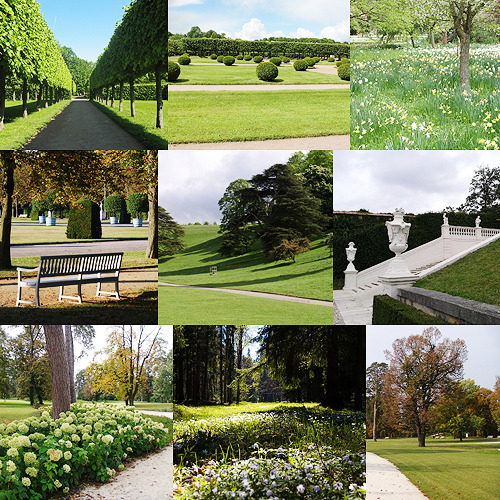
There are several copse of trees and meadows throughout the lawns and the entire estate is surrounded by a thick border of trees and shrubs. This tree border, and the twelve foot brick wall surrounding the domain affords its occupants complete privacy.

Most of the grounds and “external” gardens are accessible to the public. The only gardens not accessible to the public are the gardens between the canals and the royal and guest suites as those have direct access to the gardens. These canal-side gardens are afforded extra privacy due to walls and hedges blocking the view.
The two mews buildings are each made up of three main floors, plus a basement and attic. The west mews building is a garage for royal and staff cars. The east mews building is a stable for royal and staff horses. The domain grounds are patrolled by mounted security officers. The ground floor of each mews building are made up of the garages and stables respectively. The first floor contains offices, while the second floor and attic are used as staff accommodation. The basement contains storage and further staff common areas. The mews buildings are not open to the public (because the cars are normal cars and the horses are best left alone).

Within the Elisabeth Sybille Orangery (named for King Heinrich Ludwig I’s mother) is a restaurant which caters to both the public and royal family, and a small concert hall (which sometimes houses temporary exhibits). Inside the Amalie Greenhouse (named for Queen Karola’s mother) is a cafe, which also caters to both the public and royal family, and a swimming pool, which is never open to the public. While still rather grand, the Orangery and Greenhouse consist of only a basement and ground floor.

click here for higher resolution with more details
The site map of the Royal Domain of Euphemiasburg. The site map is entirely to scale (except for the visitor and staff car parks - I'm not sure how big car parks are supposed to be). There a dozens of interconnecting paths and riding trails on the estate not featured on the site map. The sections and wings of the palace are labelled by the predominate feature of that section of wing, it doesn’t mean that no other type of room can be found in that part of the palace. For example, above the Royal and Ambassadors Staircases are semi-state rooms.
The royal domain covers 502.85 acres or 203.5 hectares. For comparison, the Palace of Versailles’s royal domain covers 2,014 acres or 800 hectares.
Access and Visitor Information
On days the royal domain is open to the public, the grounds are accessible from 9 am to 6 pm, while the buildings are accessible from 10 am to 5 pm. No paying guests are able to take their car further than the visit car park, but a shuttle bus is available every ten minutes to ferry visitors to and from the central courtyard. Entry to the palace is through either the Royal Staircase or the Ambassador Staircase.
Photography is allowed throughout the royal domain. Flash photography is prohibited in the palace’s interiors.
Entry is €15 for adults, €10 for children, students and seniors. Entry is all inclusive. There are free guided tours of the interior and grounds every hour.
Euphemiasburg enjoys a steady flow of visitors year round, but is considered to be Mecklenburg’s hidden royal gem.
All photos are used as inspiration and to create the general feel of this fictional palace. All images are taken from Wikipedia Commons or Google Images (because Wiki Commons doesn’t have good images of kitchen gardens for some reason). I did not keep track of which real life palaces the pictures are from, but you might recognise some of them!
3 notes
·
View notes
Photo

A new portrait of Crown Princess Mary of Denmark by the artist Jesús Herrera Martínez unveiled as part of the celebration of her 50th birthday.
The portrait is painted with oil on canvas and is depicted in the Crown Prince Couple’s home in Frederik VIII’s Palace at Amalienborg, more specifically in Crown Princess Mary’s study.
The special exhibition ‘HRH Crown Princess Mary 1972-2022’ is now on at the National History Museum at Frederiksborg Palace.
199 notes
·
View notes